As a dedicated dog owner, you want to ensure your furry friend lives a long, healthy, and happy life. Part of that commitment involves providing proper nutrition and, crucially, knowing what shouldn’t you feed your dog. While some human foods are perfectly safe and even beneficial, many common household items can be highly toxic, leading to severe illness or even death. Pet poisonings are a significant concern, with hundreds of thousands occurring annually in the United States, and household foods are a major contributor. Being prepared with accurate information on foods to avoid is essential to safeguard your beloved pet.
Why Certain Foods Are Toxic to Dogs
Understanding what shouldn’t you feed your dog begins with recognizing that canine digestion and metabolism differ significantly from ours. Dogs process certain substances very differently, meaning foods safe for humans can be harmful to them. For instance, dogs metabolize compounds like theobromine and caffeine found in chocolate much slower than humans, allowing these substances to accumulate rapidly in their systems, potentially becoming fatal. Similarly, while you might enjoy cherries, the cyanide in their pits, stems, and leaves can be problematic in large quantities for dogs, and the pits themselves can cause gastrointestinal upset due to their indigestibility.
Food toxicity can also vary based on a dog’s size, breed, and existing health conditions. A small amount of a toxic substance might severely affect a small breed dog, whereas a larger dog might show milder symptoms. It’s always best to consult your veterinarian if you have any questions about specific foods your dog can’t eat.
List of Common Foods Dogs Cannot Eat
Many everyday household foods are dangerous and often toxic to dogs. This comprehensive list details common foods that are bad for dogs. Remember, this is not an all-inclusive list, so always exercise caution and consult your vet if you’re unsure.
1. Alcohol
Even small amounts of alcohol can be deadly for dogs, as their smaller bodies make them highly susceptible to its effects. Symptoms of alcohol poisoning in dogs mirror those in humans, including vomiting, breathing difficulties, coma, or even death.
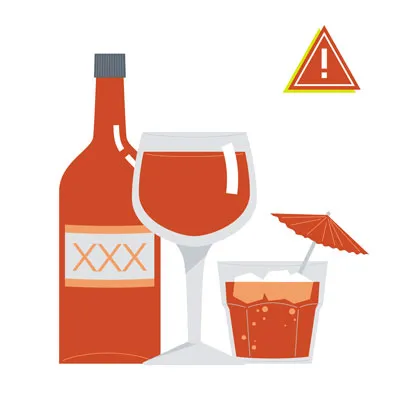 A close-up image of a glass of alcoholic beverage with ice cubes.
A close-up image of a glass of alcoholic beverage with ice cubes.
2. Apple, Apricot, Cherry, and Plum Seeds/Pits
While the fleshy part of apples is safe, apple cores and seeds contain cyanide and should be avoided. Similarly, the pits and seeds of apricots, cherries, peaches, and plums also contain cyanide, which can hinder red blood cells from carrying oxygen, leading to severe symptoms like vomiting, irregular heartbeats, seizures, coma, and even death.
3. Avocado
Avocados are not a good choice for dogs. They contain persin, which can cause issues in some animal species, and the large pit presents a significant choking hazard or can cause a gastrointestinal obstruction if swallowed whole. It’s safest to keep avocados away from your pup.
 A ripe avocado cut in half, revealing the pit and green flesh.
A ripe avocado cut in half, revealing the pit and green flesh.
4. Broccoli
Broccoli contains isothiocyanates, which can be harmful to pets in very large doses. While small amounts might be okay occasionally, there are many healthier alternatives. Broccoli stalks can also pose a choking risk or cause an obstruction.
5. Caffeine and Coffee Grounds
Caffeine contains methylxanthines, which can cause severe and potentially fatal symptoms such as diarrhea, vomiting, seizures, and an irregular heartbeat. Ingesting coffee grounds or high-caffeine drinks can cause a dog’s heart to race, leading to tremors, arrhythmia, and difficulty breathing.
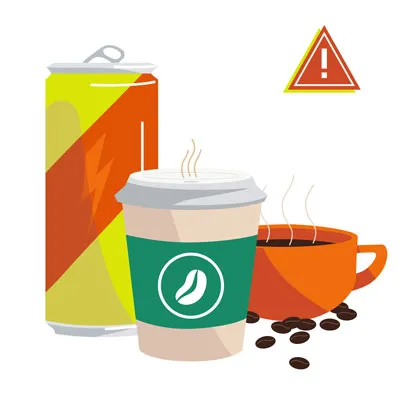 A steaming cup of coffee next to coffee beans and a coffee grinder.
A steaming cup of coffee next to coffee beans and a coffee grinder.
6. Chicken & Turkey Skin, Ham, & Other Fatty Cuts of Meat
High-fat foods like chicken or turkey skin and fatty cuts of ham are dangerous for dogs. Their high fat content can trigger acute pancreatitis, a life-threatening illness with serious complications. Bones from poultry should also be avoided, as they can splinter and cause internal damage or obstructions.
7. Chocolate
Chocolate toxicity is a common cause of pet poisoning. Chocolate contains theobromine, a lethal component for dogs, with darker chocolates having higher concentrations. It also contains caffeine, and some sugar-free chocolates may include xylitol, which is also highly toxic. Dogs cannot metabolize chocolate effectively. Symptoms include hyperactivity, vomiting, diarrhea, pancreatitis, abnormal heart rhythm, and seizures. Contact your vet immediately if your dog eats any amount of chocolate.
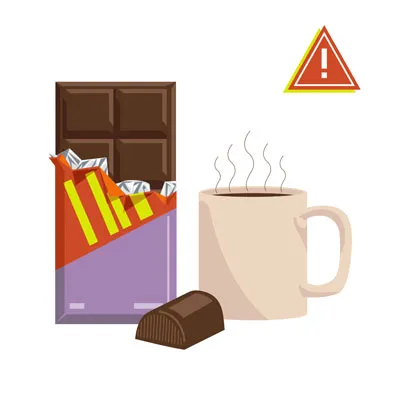 Various types of chocolate bars and pieces, including dark and milk chocolate.
Various types of chocolate bars and pieces, including dark and milk chocolate.
8. Grapes and Raisins
Grapes and raisins are exceptionally dangerous for dogs and can cause serious problems like kidney failure due to their tartaric acid. Even a few bites can wreak havoc. Symptoms of poisoning include vomiting, diarrhea, loss of appetite, and changes in urination.
 A bunch of red grapes and a small pile of dark raisins.
A bunch of red grapes and a small pile of dark raisins.
9. Macadamia Nuts, Almonds, & Pistachios
Macadamia nuts are toxic to dogs, causing symptoms like weakness, overheating, and vomiting, even in small quantities. While the exact mechanism is unknown, as few as six nuts can severely poison a small dog. Other nuts, like pistachios and almonds, can be choking hazards, especially if flavored or spiced.
10. Milk & Dairy Products
The safety of milk and other dairy products varies among dogs. Many dogs are lactose intolerant or allergic, experiencing diarrhea and gas if they consume cow’s milk. Ice cream is generally bad due to high sugar and fat content. Small quantities of lower-fat cheese can be acceptable as an occasional treat.
11. Mushrooms
It’s best to avoid feeding your dog mushrooms altogether, as many varieties contain toxins that can cause kidney and liver failure, vomiting, diarrhea, hallucinations, and red blood cell damage. While washed white mushrooms from grocery stores might be okay, choosing a different, safer treat is always preferable.
12. Nutmeg & Cinnamon
Nutmeg is toxic to dogs, potentially causing hallucinations and severe vomiting due to the compound myristicin. Cinnamon should also be avoided, not necessarily because it’s toxic, but because it can irritate a dog’s mouth and lead to dangerous drops in blood sugar.
13. Onions, Garlic, Chives, & Leeks
These members of the allium family contain sulfoxides and disulfides, which can damage red blood cells and cause anemia in dogs and cats. Onion and garlic powders are common in many prepared foods, so always check labels. All allium plants can cause potentially fatal anemia, with certain Japanese breeds like Akitas and Shiba Inus being particularly sensitive.
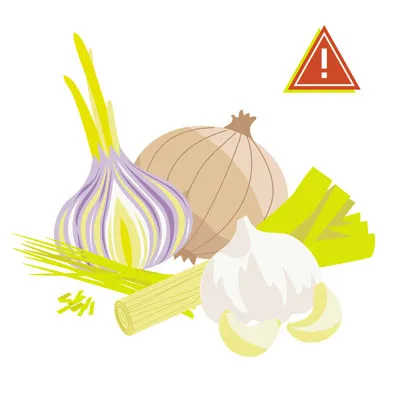 A collection of onions, garlic cloves, fresh chives, and leeks on a cutting board.
A collection of onions, garlic cloves, fresh chives, and leeks on a cutting board.
14. Salt
Excessive salt intake can disrupt a dog’s cellular fluid balance, leading to tremors, seizures, diarrhea, or even a coma. Whether it’s rock salt, homemade play dough, or potato chips, keep salty items out of your dog’s reach.
15. Spicy Food
Spicy foods are a definite no-go for dogs. They can cause painful vomiting, stomach ulcers, or diarrhea, potentially leading to emergency veterinary visits.
16. Sugar-Free Gum & Candy (Xylitol)
Xylitol is an artificial sweetener found in many sugar-free products like gum, candy, and baked goods. In dogs, it causes a rapid and dangerous drop in blood sugar, leading to weakness, seizures, and even liver failure. The amount of xylitol in just five pieces of gum can be fatal to a 65-pound dog, highlighting the critical importance of knowing what shouldn’t you feed your dog and keeping such items secured.
 An assortment of sugar-free gum and candies in their wrappers.
An assortment of sugar-free gum and candies in their wrappers.
17. Tomatoes and Raw Potatoes
Ripened red tomatoes are generally safe, but the green parts of the tomato plant and unripe green tomatoes contain solanine, which is toxic to dogs. Similarly, cooked potatoes (without additives) are fine in small amounts, but raw potatoes also contain solanine and are toxic.
18. Tobacco
Tobacco products contain nicotine, which is highly dangerous for dogs. Exposure can cause vomiting, diarrhea, rapid breathing, agitation, abnormal heart rate, wobbliness, muscle weakness, blood pressure issues, seizures, and tremors. More severe exposure can lead to blue gums, coma, and even death. If your dog ingests tobacco, seek immediate veterinary care.
19. Yeast and Raw Dough
Yeast and raw dough are extremely unsafe. Raw dough can expand in a dog’s stomach, causing severe pain and potentially life-threatening stomach torsion or rupture. Additionally, the yeast and sugar ferment, producing alcohol, which can lead to alcohol toxicity and requires immediate medical intervention.
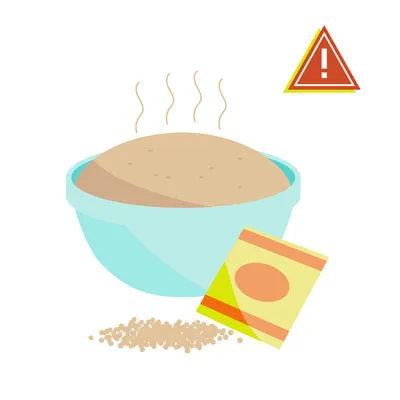 A bowl of raw bread dough rising on a kitchen counter.
A bowl of raw bread dough rising on a kitchen counter.
20. Raw Meat
Never feed your dog raw or undercooked meat. Raw meat can harbor harmful bacteria like Salmonella or E. coli, which can affect both dogs and humans. Additionally, bones in raw meat pose a choking hazard.
21. Rhubarb
Rhubarb, commonly used in desserts, is not safe for pets. Its leaves contain soluble calcium oxalate crystals. In large enough quantities, these can bind with calcium in the body, causing a dangerous drop in calcium levels and potentially leading to renal (kidney) failure. Symptoms include tremors, weakness, drooling, bloody urine, and changes in thirst and urination.
22. Star Fruit
Similar to rhubarb, star fruit also contains soluble calcium oxalate crystals and should not be given to dogs.
23. Flavored Water and Seltzer Water
It’s always best to give your dog fresh, clean, plain water. Flavored or carbonated waters can contain added sugars, salts, or artificial sweeteners (like xylitol) that are dangerous. Plain seltzer water might be okay in tiny amounts if absolutely necessary but can cause gas and bloating.
What Dogs Are Most at Risk if They Consume Toxic Foods?
While all dogs should avoid toxic foods, some are more vulnerable:
- Small breeds: Due to their lower body weight, small dogs are more susceptible to the effects of toxic substances like chocolate.
- Puppies: Young dogs have less developed digestive and immune systems, putting them at greater risk from certain substances.
- Elderly dogs: Older dogs may have pre-existing health conditions that increase their risk.
- Dogs with pre-existing conditions: Conditions like diabetes or kidney disease can make a dog more vulnerable to food toxicities.
How To Prevent Dogs from Eating Toxic Foods
Accidents happen, but proactive steps can minimize the risk of your dog ingesting unsafe human food.
1. Store Foods Out of Reach
Ensure all toxic foods are kept in high shelves or locked cabinets that your dog cannot access. This simple step can prevent many potential incidents.
2. Avoid Feeding Dogs from Your Plate
Resist the urge to share food from your plate, or while you’re cooking in the kitchen. It’s safest to only offer treats specifically formulated for dogs. For healthy dog-friendly options, explore articles like what is the best vegetable for dogs to eat.
3. Educate Family Members and Guests
Inform everyone in your household, including children and guests, that no human food should be given to your dog, no matter how much they beg. This consistent approach helps reinforce safe habits.
4. Be Careful During Holidays
Holidays often involve more food preparation and guests, making it easier for vigilance to slip. Be extra cautious during these times to prevent accidental ingestion of toxic foods.
If, despite your precautions, your dog eats something toxic, swift action is crucial. Keep emergency vet and poison control contact information readily available.
What To Do if Your Dog Eats Something Toxic
If you suspect your dog has eaten toxic food, seek help as quickly as possible. Familiarize yourself with common symptoms of food toxicity, which can include listlessness, distress, pain, vomiting, bloody stools, or a bloated and hard stomach. If you notice these signs, follow these steps:
- Call your veterinarian or poison control immediately: Time is critical. Treatments are more successful, and hospitalization may be shorter if a dog receives prompt help.
- Be prepared with information: Have details ready, such as the type of food eaten, the estimated amount consumed, and the time of ingestion.
- Avoid home remedies: Do not attempt home remedies unless specifically advised by your veterinarian, as some can be harmful depending on the ingested substance.
Pets Best Can Help You Keep Your Dog Healthy
Keeping track of what shouldn’t you feed your dog can be challenging, but this guide provides essential information to help keep your canine companion safe from harmful foods. There are also many safe and healthy human foods your dog can enjoy, as discussed in articles like what human food is best for dogs and what can i feed my dog. Always consult your veterinarian if you are unsure about any food item.
Pet insurance is an excellent way to prepare for unexpected emergencies, including those caused by accidental ingestion of toxic foods. Pets Best offers customizable dog and puppy insurance plans and a 24/7 Pet Helpline for policyholders, providing access to veterinary experts whenever you have concerns about what your pet may have eaten.
References
- “Top 10 dog poisons,” Hilary Parker (5/2023), WebMD.
- “What happens if a dog eats chocolate?” (10/2023), Colorado State University.
- “Fruits and vegetables dogs can or can’t eat,” (3/2024), American Kennel Club.
- “What to do if your dog drinks alcohol,” Jerry Klein (7/2023), American Kennel Club.
- “Can dogs eat apples?” Hector Joy (12/2022), PetMD.
- “Can dogs eat plums?” Katie Koschalk (7/2023), Chewy.
- “Avocado (Persea spp) Toxicosis in Animals,” Cristine Hayes (9/2024), Merck Veterinary Manual.
- “People foods to avoid feeding your pets,” (n.d.), ASPCA.
- “People foods dogs can and can’t eat,” (3/2024), American Kennel Club.
- “Can dogs eat nuts?” Amanda Ardente (1/2023), PetMD.
- “Can dogs drink milk?” Sandra C. Mitchell (1/2024), PetMD.
- “Can dogs have nutmeg?” Barri J. Morrison (11/2023), PetMD.
- “Onion, garlic, chive, and leek poisoning in dogs,” Renee Schmid et al. (2024), VCA Animal Hospitals.
- “Can dogs eat tomatoes?” Anna Burke (10/2024), American Kennel Club.
- “Can dogs eat potatoes?” Katherine Ripley (11/2023), American Kennel Club.
- “What to do if your dog eats a cigarette butt,” (6/2023), American Kennel Club.
- “Dough & dogs: Why it’s bad and what you can do,” Lisa Goldstein (7/2024), Preventive Vet.
- “Rhubarb,” (n.d.), Pet Poison Helpline.
- “Can dogs drink carbonated water?” Heather Logue (n.d.), Rover.
- “What fruits can dogs eat?” Ellen Malmanger (2/2024), PetMD.
- “Can dogs have green beans?” Anna Burke (8/2022), American Kennel Club.
- “About pet food safety,” (4/2024), CDC.
